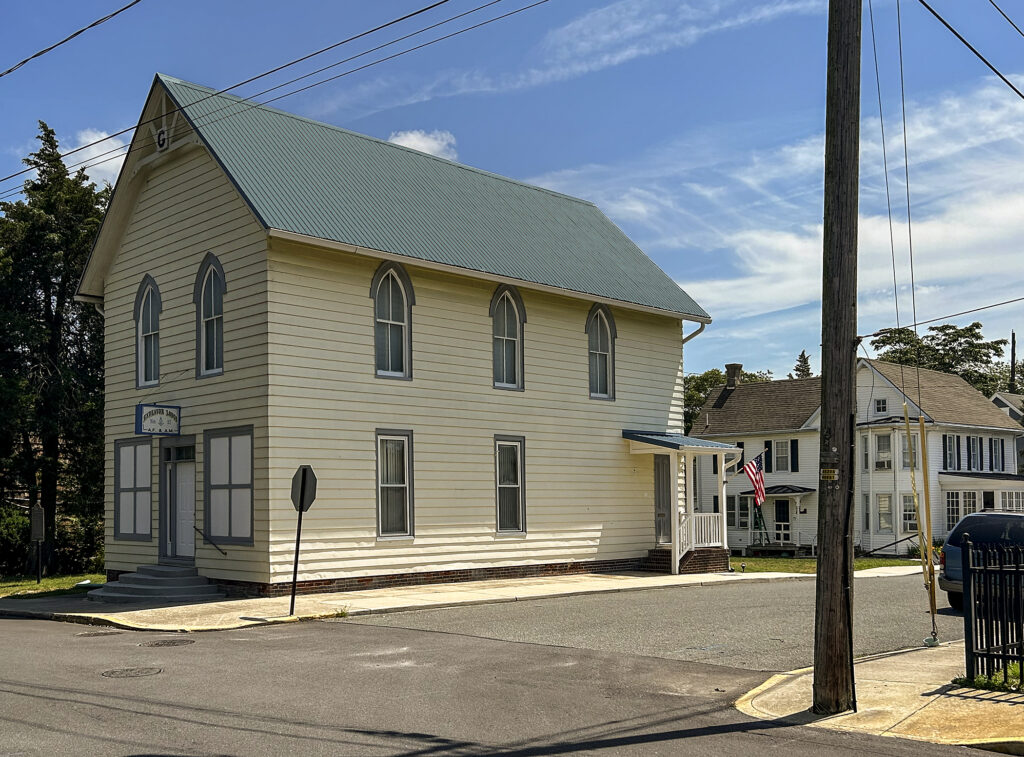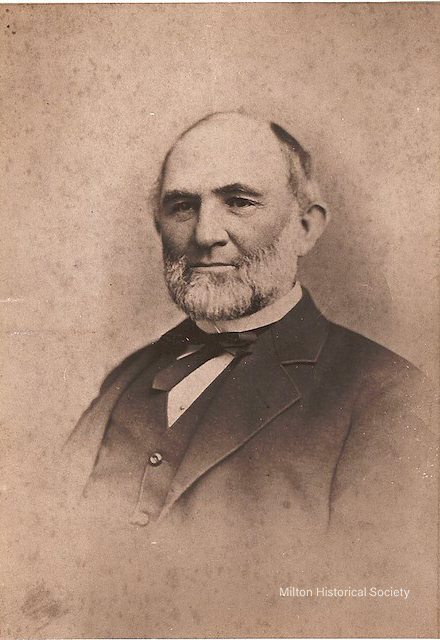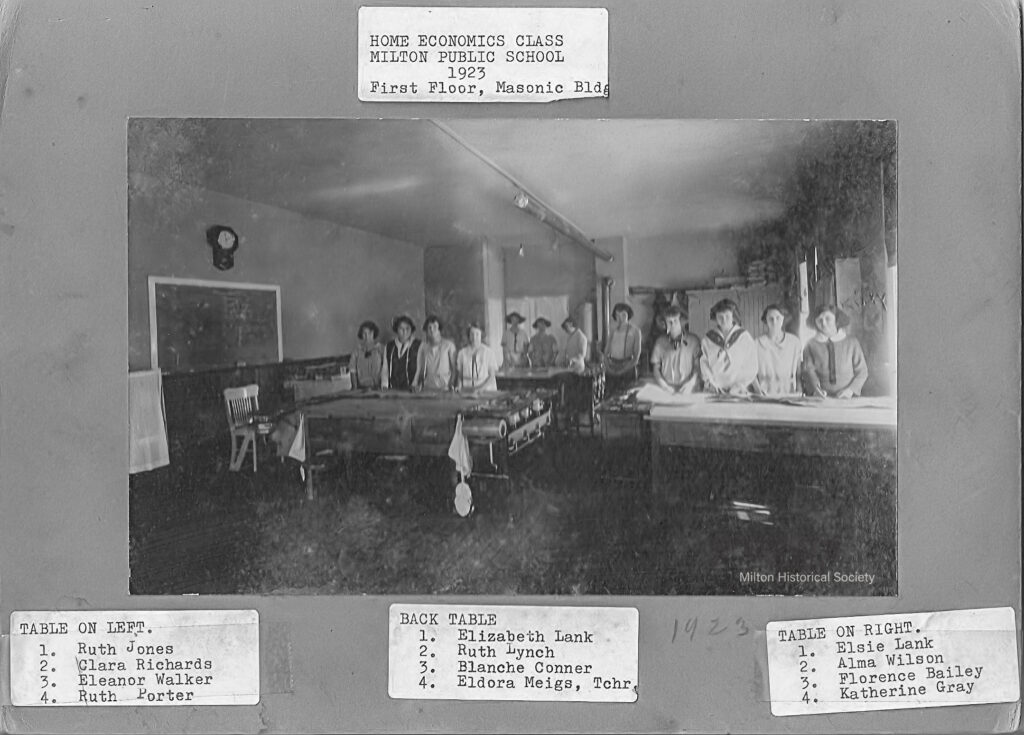On June 27, 1848, the Grand Lodge of Delaware, which governed all Masonic lodges in the state, approved the petition of a small group of prominent Milton men to form Endeavor Lodge 17. The charter for the Milton lodge was transferred from Frederica, where the order had ceased to exist for some years. Endeavor Lodge 17 is now 175 years old – the oldest fraternal order in Milton.
In the Act of Incorporation submitted to the state legislature three years later, the order was referred to as “Ancient York Masons,” although today most Masonic lodges in this state and elsewhere are either “Ancient Free and Accepted Masons” (A.F. & A.M.) or “Free and Accepted Masons” (F. & A.M.). These names referred to rites, or progressive degrees, conferred by a Masonic organization on its members. The two modern rites recognize and respect each other; Endeavor Lodge 17 follows the A.F. & A.M. rite.
The Endeavor Lodge building stands on the southeast corner of Mill and Chestnut Streets, overlooking Goshen Cemetery and the final resting place of many of its members. It dates to 1883 when the land it stands on was conveyed to the Lodge by Samuel J. Martin, a Lodge brother and son of one of Milton’s great shipbuilders. Prior to the construction of the building, the Endeavor Lodge is thought to have held its meetings in James Ponder’s store.
A Multipurpose Building
The two-story plan of the Lodge building provided for a store or other form of commercial use on the first floor, and meeting rooms for the Masons on the second floor. One of the earliest available photographs of the Lodge shows the Chestnut Street side of the building with a storefront entrance and windows.


The Charter Members
Through meeting records, legal petitions and newspaper articles, we know the names of the charter members who founded the Lodge in 1848 and would effectively run it for about twenty years. It is worth looking at the founders’ stories to get an idea of what kind of organization this was.

James Ponder (1819 – 1897) is far and away the best known of the charter members. He was one of Milton’s “Five Governors,” serving Delaware in that office from 1871 – 1875. Prior to that he was a State Senator from 1865 – 1869 and a State Representative from 1857 – 1859. Ponder was a merchant and hotelier before, during, and after his career in politics. Over a 50 year period, he invested in twenty-four Milton-built cargo schooners and an undetermined number of ships built elsewhere, using most of these exclusively to transport freight from the Milton docks to Atlantic coast cities. He was the first “Worshipful Master” (head officer of the Lodge).

of Endeavor Lodge 17 (undated photo courtesy Milton Historical Society)
Theodore W. Parker (1825 – 1902) was involved in Milton’s maritime industry, investing in the E. C. Knight in 1859 and the James Satterthwaite in 1861. He eventually moved to Philadelphia, worked various jobs there, and ending his working life in a supervisory job with the Pennsylvania Railroad. Parker was the Lodge’s first “Senior Warden” (second ranking officer).
Rouse Fassit Young (1806 – 1852) was a ship captain, master of the David Hazzard built in 1837 of which he was also co-owner. He later turned to farming. Young was elected Senior Deacon, the first to hold that rank in the Lodge.
James Cooper (1801? – 1882) was listed as a sailor in census records, and later as a butcher. Little else is known about him.
Benton H. Johnson (1821 – 1894) was a ship captain, commanding the Milton-built Wave in 1843; he served in the 9th Delaware Infantry during Civil War, and later turned to farming. He was also a Temperance movement organizer in 1886. Johnson was elected Junior Deacon, the first to hold that rank in the Lodge.
Henry W. Johnson (1809 – 1880) was a ship captain, master of four Milton-built vessels: the Hope (1838), the Farmer (1848), the Messenger (1853), and the Curtis Wright (1865). He was also Benton Johnson’s older brother.
Samuel James Wilson (1820 – 1849), not to be confused with S. J. Wilson the undertaker, was the first Treasurer of the Lodge. For some reason, even though his name appears seventh among the first nine members recorded in the Lodge’s minutes book, written in the same hand with the same ink, historian Thomas Scharf omits him from the list of charter members. My opinion, however, is that he was indeed one of the them. Very little is known about Wilson’s life or career. He was the son of Dr. Simon K. Wilson and Mary Paynter, but lost his mother shortly after he was born. He is known to have invested in one Milton-built ship, the Clara, in 1847. Wilson died young, barely a year after the Lodge was established, after having lost his wife in childbirth in 1845 and his infant son barely two months later.
John B. Mustard (1808 – 1885) was a shipbuilder responsible for the construction of the Atlantic in 1839 and John W. Houston in 1844; he later left the industry to become farmer. As is the case with Samuel J. Wilson, his name was omitted from the list of charter members even though his signature appears eighth among the first nine. He was elected Tyler (a type of ceremonial guard), and was the father as well of two Lodge brothers: George H. Mustard and John H. B. Mustard. Thomas Scharf mistakenly identifies John B. Mustard among the charter members as “John H. B. Mustard,” his son, who joined the Lodge later.
Elisha Holland (1805 – 1888) was a farmer, but he also operated a grist mill starting in 1859 and a saw mill starting in 1868. He commanded the Milton Home Guard in 1861 with rank of Captain. Holland was the Lodge’s first “Junior Warden” (third ranking officer).
Of these nine charter members, seven were directly involved in the town’s maritime industry, either as investors in or as mariners. Three were commanders of vessels. Most of them, particularly James Ponder, were affluent or at least financially comfortable; sea captains, if they survived the dangers of wooden sailing ship voyages, accumulated substantial funds from successful trips in which they shared in the profits.
The other thing these men had in common was their relative youth. All were under fifty years of age, with Ponder, Wilson, Parker and Benton Johnson in their twenties. Milton’s shipbuilding-based economy was approaching its zenith in the mid-19th century, and the Lodge membership were big players in that space. Risk-taking, skill, and high energy – all of which were required to survive and thrive in the maritime industry – were attributes more often found in younger men than in their elders. The first brothers of Endeavor Lodge 17 were Milton’s rock stars.
Subsequent early members, 1849 – 1869
The Lodge membership expanded rapidly after its founding. Some of the names on its roster are obscure, or represent individuals who elected not to continue with the long process of development into full-fledged members. Other names are more familiar to us today, and those are the ones listed below.
Peter P. Johnson (1826 – 1863, initiated 1850 or earlier), brother of Henry and Benton Johnson, gave his occupation on the 1863 draft registration as “mariner.”
James E. Blizzard (1828 – 1893, initiated 1850 or earlier) joined the Lodge shortly after it was chartered and was elected its first Secretary while in his early twenties. The 1850 census listed his occupation as schoolteacher. Little is known about him while he was a Milton resident, but we do know that he left Milton and Delaware sometime before the Civil War. In 1860, the census reported him living in Cambridge, MD, with the occupation of minister. The 1870 census listed his occupation as “Degarian artist,” which is most likely a misinterpretation of “Daguerreotype artist” – in other words, he was a photographer, located in Bellefontaine, OH. Blizzard’s next occupation was “newspaper editor,” according to the 1880 census, in Celina OH. By 1885, he was living in Lincoln, Nebraska, and gave his occupation as “druggist.” His final resting place was in Firth, Nebraska, south of Lincoln. Among the early members, James E. Blizzard ended up the furthest away from Milton – about 1300 miles west.
George H. Mustard (1823 – 1885, initiated 1850 or earlier), a ship carpenter and son of John B. Mustard, was a long-time trustee of the Milton Methodist Protestant Church (now the Lydia B. Cannon Museum).
James M. Baynum (1822 – 1901, initiated 1850 or earlier), a ship captain, commanded the Milton-built Clara in 1847 and the Peter J Hart 1879. Later in his career, he was the first pilot on the paddle-wheel steamer Republic, which ran from Philadelphia to Cape May.
William Jefferis or Jeffries (? – August 3 1863, initiated 1850 or earlier) was a ship carpenter, credited with building the Thomas H. Benton in 1835. Little else is known about him,
John C. Lacey (1827 – 1914, initiated 1850), a ship captain, commanded the Milton-built Greensbury Willey in 1864.
William Sterling Holland (1830 – 1902, initiated 1854), a ship captain, sailed mostly out of Philadelphia. He was the son of Lodge brother Elisha Holland. The most interesting anecdote of his life relates to his last voyage in 1893, when his entire crew died of yellow fever in Santos, Brazil, while waiting nearly a year for a berth to discharge their cargo.
Samuel Martin (1804 – 1879) was one of Milton’s most successful and prolific shipbuilders and investors. He owned the shipyard on Front Street which today is used by the Milton Fire Department as a parking lot. He built his first vessel, the Norris, in 1828, then at least seventeen more, the last of which, the Annie E. Martin in 1861, was likely named for his daughter. These are vessels for which documentation has been found; he may have built a few more. He was a trustee of the Methodist Episcopal Church, and in that capacity participated in the acquisition of the lot on lower Federal Street in 1874 where the original Goshen M. E Church was built. In 1883 his son and heir Samuel J. Martin (1840 – 1918, inititated 1864) conveyed to Endeavor Lodge 17 the lot on which the present-day building stands.
Henry Howell Ellingsworth (1835 – 1909, initiated 1858), a ship captain, commanded the Milton-built Denie Hastings in 1864 and the Melvina in 1866.
James A. Hopkins (1834 – 1912, initiated 1861), was Milton’s pre-eminent physician for decades.
John H. B. Mustard (1835 – 1898, initiated 1861) was a secretary to James Ponder and held many white-collar positions in Sussex County. He was the son of Lodge brother John B. Mustard.
Theodore Emery Atkins (1841 – 1875, initiated 1863), a ship captain, commanded the Milton-built E. G. Irwin in 1865 and the Frank Atkins (named for his son). He was an investor in George W. Fenimore, built in 1883 by his brother David Hazzard Atkins and one of the largest vessels ever built in the Milton yards.
George E. Kimmey (1839 – 1917, initiated 1864), a ship captain, commanded the Milton-built Marian H. Rand from 1873 to 1875. J. B. Welch, druggist and songwriter, dedicated his song The Old Church in the Graveyard to Kimmey, referring to the old Methodist Episcopal Church that once stood in Goshen cemetery.
David L. Hudson (1830 – 1904, initiated 1864), a ship captain, was also an investor in the A. P. Nowell, built in Milton in 1880.
David Hazzard Atkins (1843? – 1904, initiated 1864), a seaman turned ship builder, constructed 17 vessels between 1867 and 1887, including some of the largest and broadest three-masted schooners ever built in the Milton yards. He was the brother of Theodore Emery Atkins.
Miers C. Darby (1801 – 1875, initiated 1864), a ship captain, commanded the small Milton-built Canton in 1834 and other vessels.
From this partial list, it is safe to surmise that shipbuilders and ship captains were pillars of Milton’s economy, and a class unto themselves, for several decades after the founding of the Lodge. This list, however, omits almost an equal number of lesser-known farmers, merchants, and transient members, or those for whom information is not available.
1870 – 1920
The next few decades saw a continued growth, with more brothers coming from outside the maritime industry. Some of the better-documented of these were Thomas H. Douglass and N. Wallace White, partners in the Douglass & White Shirt and Overall Factory; Isaac Nailor and Frederick Pepper, contractors who rebuilt much of the downtown area after the fire of 1909; Dr. J. C. Wiltbank, a dentist; and Samuel J. Wilson, a merchant and Milton’s most successful undertaker. Barbershop owner William H. Mears, who contracted with Isaac Nailor to build 102 – 106 Federal Street in 1909, was initiated during this period, along with Charles H. Atkins, successful merchant, investor in thirteen Milton-built vessels, and one-time Treasurer of the State of Delaware. Even so, a good number of sea captains were also initiated into the Lodge during these years: John Fletcher Fisher, Charles Franklin Lacey, James C. Conwell, Megee brothers George and John, Reuben Pennewill, Daniel R. Burton, and Lucius Darby.
Sources
I would first like to express my thanks to the brothers of Endeavor Lodge 17, A. F. of F. M., for allowing me to visit with them, hear their stories about the history of the Lodge, and to examine its membership rolls dating back to the founding in 1848. Without their collaboration, this article would not have been possible to write.
Hancock, Harold and McCabe, Russell, Milton’s First Century 1807 – 1907
Conwell, Captain T. C., Ships and Men of the Broadkill
Milford Chronicle, 1880 – 1930
Scharf, Thomas. History of Delaware





Very interesting. Thanks for taking all the time to get all that information. It is very important that this history not be forgotten. Thanks again for all your hard work.
Elizabeth Lank Shivelhood lived on Walnut St., her father was the Bank (Sussex Trust) President and was the first grade teacher at Milton Consolidated and HOB schools. Alma Wilson lived on Federal next to the church, was never married. Her father was the Undertaker.
My first grade teacher was Elizabeth Lank Shivelhood from 1955 to ’56. She was well known and well respected in that role. I remember that her favorite candy was The Three Musketeers bar. She used to enjoy one at her desk after lunch.
In later years, I found her to be a very interesting person who had lived in New York City at the time when she attended Columbia University. I was very disappointed when she became ill and was unable to keep a visit my parents had planned to meet my wife, Carol.
I remember walking every Saturday to the library and bringing home Nancy Drew mysteries to read and reread. There was once a “picnic” beside the graveyard and trying to catch a greased pig as part of the fun.
I remember Miss Shivelhood and her 1st grade. Thank you for bringing back some childhood memories.
Always my pleasure to bring the memories back for someone. I didn’t grow up here, but sometimes I feel like I lived here in a previous life, more than a century ago. Some would say I’m spending too much time diving into the research!